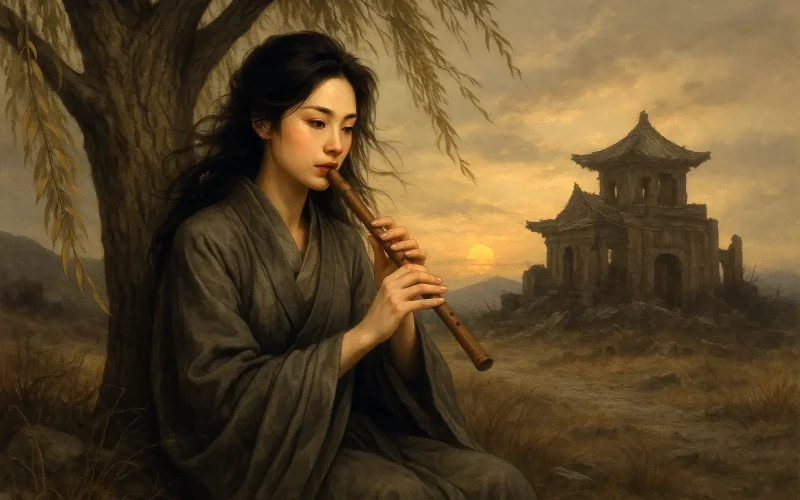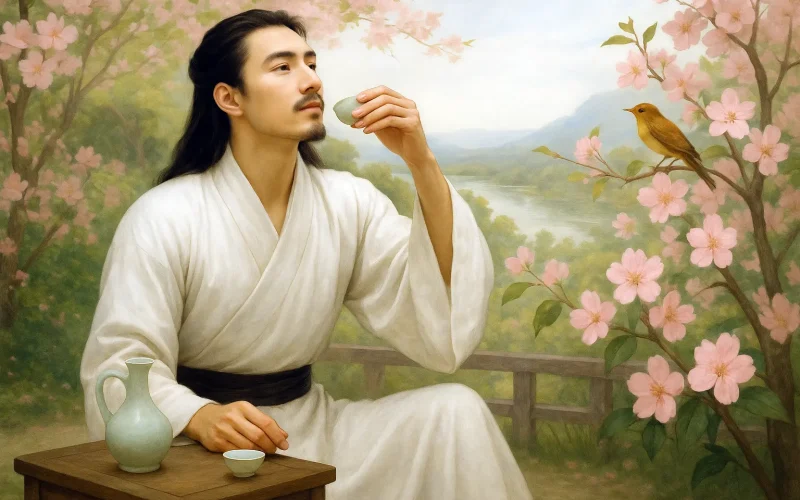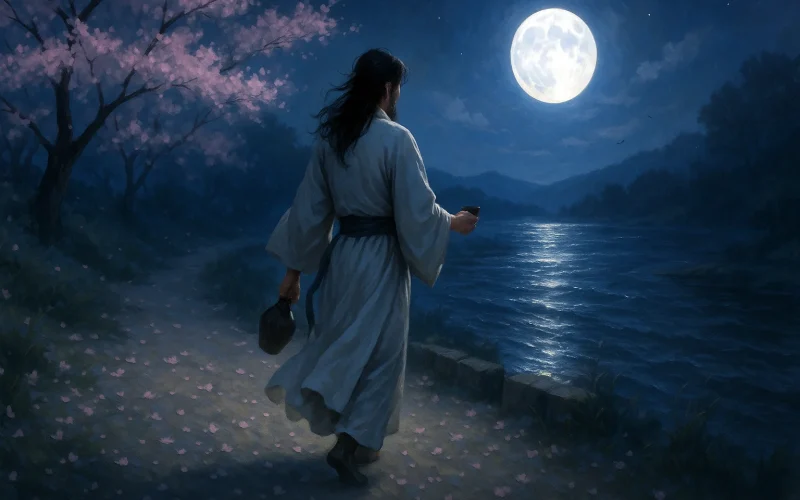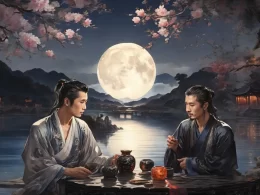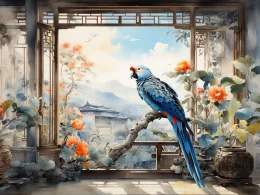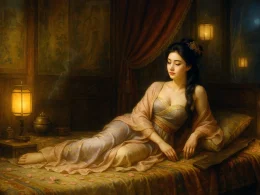The sound of the flute chokes.
The lady of Qin’s dream breaks under the moon on the Qin tower.
The moon on the Qin tower—
Year after year, the willow’s color:
The sorrowful parting at Baling.
On the Leyou Plateau, the Clear Autumn Festival;
On the ancient road of Xianyang, news and dust are cut off.
News and dust are cut off—
A western wind, the remnant sunlight
On the Han dynasty’s tombs and watchtowers.
Original Poem
「忆秦娥 · 箫声咽」
李白
箫声咽,秦娥梦断秦楼月。
秦楼月,年年柳色,灞陵伤别。
乐游原上清秋节,咸阳古道音尘绝。
音尘绝,西风残照,汉家陵阙。
Interpretation
This work portrays the longing of a capital-dwelling woman, "the lady of Qin," for her distant lover, while using historical sites like Leyou Plateau, Xianyang Ancient Road, and Han Dynasty imperial tombs to reflect on life's partings and the impermanence of worldly affairs. The poem conveys profound emotion within a desolate atmosphere, blending personal sentiment with the rise and fall of history, possessing exceptional artistic value.
First Couplet: "箫声咽,秦娥梦断秦楼月。"
Xiāo shēng yè, Qín é mèng duàn Qín lóu yuè.
The flute’s notes choke with grief; Qin E’s dream shatters under the moon over Qin’s tower.
The poet opens with "the flute’s notes choke," establishing a sorrowful atmosphere. "Qin E" symbolizes a woman separated from her love; her dream is shattered by the mournful flute, and waking to the lonely moonlight deepens her melancholy. This line expresses not only the pain of separation but also how the flute’s sound intensifies emotion, enveloping the entire poem in a plaintive mood.
Second Couplet: "秦楼月,年年柳色,灞陵伤别。"
Qín lóu yuè, nián nián liǔ sè, Bà líng shāng bié.
The moon over Qin’s tower returns; Year after year, the willows green again, mourning partings at Ba Ling.
The reappearance of "the moon over Qin’s tower" echoes the previous line and emphasizes its cold solitude. Willows have long symbolized farewell; "year after year, the willows green" suggests the passage of time, while the sorrow of parting remains unchanged. "Mourning partings at Ba Ling" specifies the farewell site, making the emotion more concrete and genuine.
Third Couplet: "乐游原上清秋节,咸阳古道音尘绝。"
Lèyóu yuán shàng qīngqiū jié, Xiányáng gǔdào yīn chén jué.
On Leyou Plateau, the Clear Autumn Festival; On Xianyang’s ancient road, all news and traces cease.
"Leyou Plateau" was an ancient vantage point for gazing into the distance. The crisp, austere feeling of autumn accentuates the figure’s loneliness. "All news and traces cease" vividly depicts her desperate wait with no word from afar, reflecting both reality and the ruthlessness of fate.
Fourth Couplet: "音尘绝,西风残照,汉家陵阙。"
Yīn chén jué, xīfēng cán zhào, Hàn jiā líng què.
All news and traces cease; The west wind sweeps under the fading sun, shrouding the Han imperial tombs.
Repeating "all news and traces cease" deepens the despair of longing. "The west wind sweeps under the fading sun" paints a desolate scene: the autumn wind blows as sunset glow falls upon the Han tombs, symbolizing the passage of time and historical vicissitudes. This imagery elevates the poem’s emotion from personal sorrow to reflections on historical rise and fall and the impermanence of worldly affairs, enhancing its depth.
Holistic Appreciation
This lyric expresses the sorrow of parting through the longing of "the lady of Qin," while its depiction of historical sites lends the work a profound and far-reaching conception. The emotional progression moves from the lament of a shattered dream, to memories of past farewells, then to the anticipation of gazing into the distance, ultimately culminating in reflections on the impermanence of life beneath the autumn wind and fading light. The poet skillfully employs imagery to advance the emotion layer by layer, creating an artistic atmosphere that is both subtle and deeply resonant.
In its depiction of scenery, the poet uses highly evocative imagery: the flute’s mournful notes establish a sorrowful mood; the cold, clear moon symbolizes solitude and helplessness; the willows' perennial green reflects the enduring nature of parting sorrow; the desolation of the Xianyang ancient road hints at the hopelessness of waiting; and the dying light upon the Han imperial tombs elevates personal grief to the level of historical rise and fall. These scenes are not merely depictions of reality but also carry profound emotional weight, adding tension and depth to the poem's meaning.
In terms of emotional expression, the poet not only reveals personal sorrow but also, through the imagery of the "Han imperial tombs," elevates the lyric beyond mere romantic longing to touch upon the brevity of life and the uncertainty of worldly affairs. The contrast between the woman's yearning and the decay of the ancient road and imperial tombs makes the pain of separation appear vast and profoundly melancholy within the flow of history. The work relates a personal grief while also subtly mirroring the cyclical nature of historical rise and fall, leaving the reader with a deep sense of poignant reflection.
Artistic Merits
- Scene-Emotion Fusion, Enhanced Impact: The poet deftly uses natural scenery and historical sites, giving the lyric strong visual appeal and emotional resonance.
- Precise Structure, Clear Layers: The emotion progresses logically from personal longing to historical reflection, creating a sense of layered development and tension.
- Subtle Allusions, Expansive Conception: References like "parting sorrow at Ba Ling" anchor the farewell in a specific place, while "Han imperial tombs" evoke historical vicissitudes, lending the poem a philosophical dimension beyond personal sentiment.
Insights
This lyric reminds us that life is full of unpredictable meetings and partings; the pain of separation has always been a major theme for writers. The repeated emphasis on "the willows' perennial green" makes us aware that the passage of time cannot diminish deep emotions, just as many reunions and farewells in life are inevitable. Cherishing the present is the only way to minimize regret. Furthermore, by using historical imagery to connect personal sorrow with the fate of a nation, the poem prompts us to reflect on broader historical and philosophical truths while contemplating our own lives. Separation is not merely a farewell between individuals but also part of time's relentless flow, in which we constantly bid farewell to the past and welcome the future.
About the poet
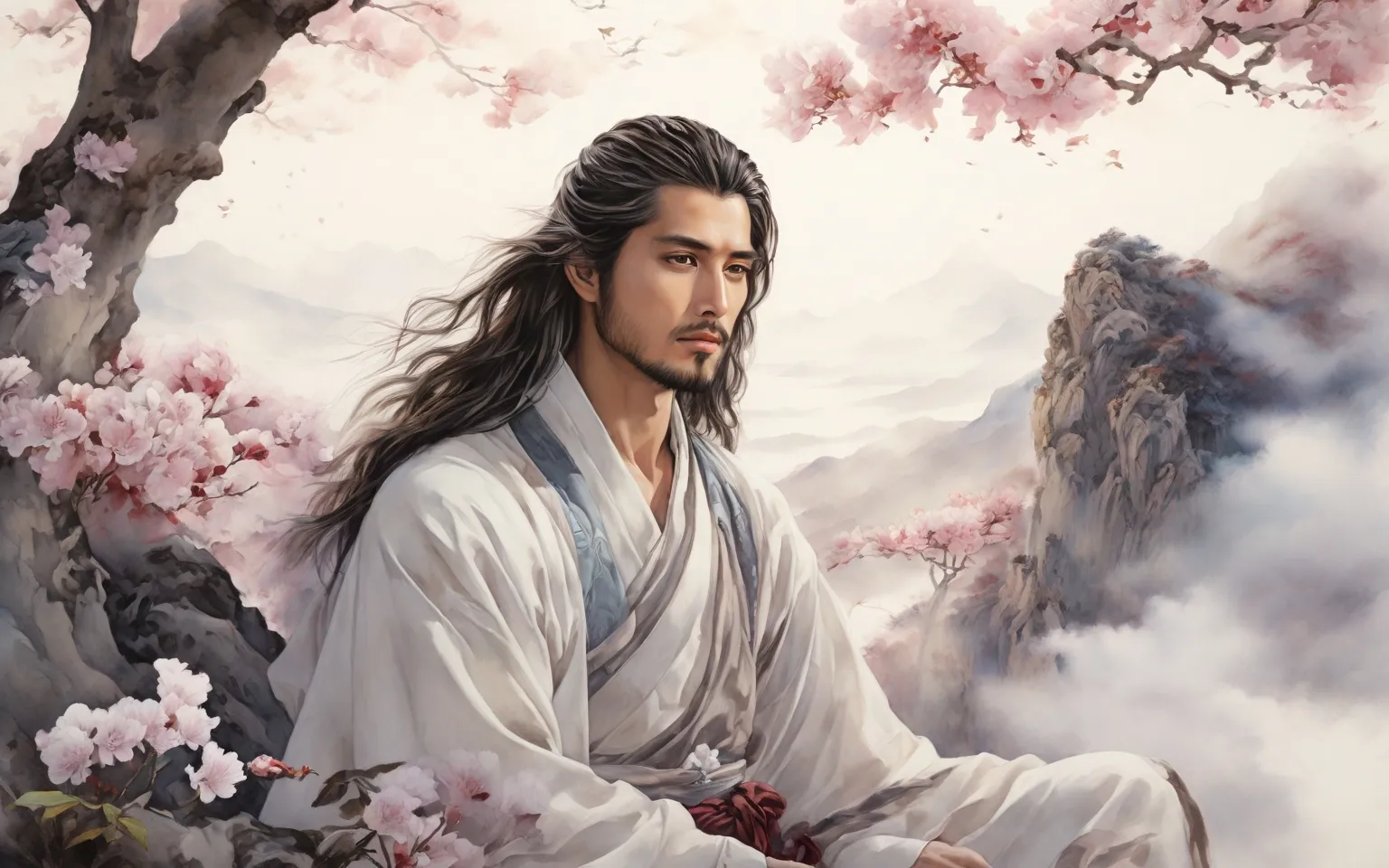
Li Bai (李白), 701 - 762 A.D., whose ancestral home was in Gansu, was preceded by Li Guang, a general of the Han Dynasty. Tang poetry is one of the brightest constellations in the history of Chinese literature, and one of the brightest stars is Li Bai.






